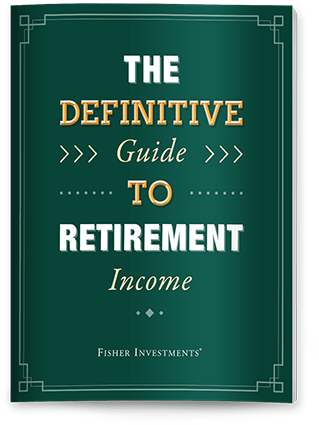Investing for Your Retirement
There is no single recipe to successfully investing for retirement. Your long-term retirement objectives, time horizon and unique financial circumstances should largely determine whether you should focus on growth, income or a combination of the two to help fulfill your financial needs.
We believe your asset allocation—the overall mix of stocks, bonds, cash and other securities in your portfolio—drives as much as 70% of the potential returns over time. We further believe your portfolio’s asset allocation is key to understanding your portfolio’s return expectations and risk.
The array of investment vehicles available can make retirement planning seem bewildering. As a firm serving more than 190,000 clients1, Fisher Investments has extensive experience in understanding how to assemble a sound plan to support a wide range of investment goals. We’ll take a look at a few of the main options you may consider for your retirement investments.
Types of Retirement Investments
While there are a wide variety of securities available, there are some key types of securities you’re likely to come across when deciding how to invest for your retirement:
- Stocks represent “partial” ownership in a business. Of all asset classes, stocks have historically shown to be one of the best and most consistent investments for generating higher long-term returns.2 However, stocks can also be subject to high volatility in the short term.
- Bonds are essentially loans investors make to a company or entity to be repaid at a specific time and at a specific interest rate. Bonds have historically provided lower returns than stocks3, but they can potentially offer more reliable income with less short-term volatility.
- Mutual Funds allow investors to benefit from a professionally managed, potentially well-diversified portfolio of assets by pooling money with other investors. These can be a great option for investors who are getting a start, but mutual funds’ fees (paid to the fund’s manager and, in some cases, salespeople and others) can add up.
- Exchange-Traded Funds (ETFs) are similar to mutual funds, but with some key differences. Like a mutual fund, they are pooled monies from multiple investors. However, while mutual funds can be bought and sold at a fixed price that updates once a day, ETFs prices are dictated by the market at any given time during market hours.
Types of Retirement Investments: Real Estate
Investing in real estate can be a way to generate retirement income. However, the benefits of real estate should be compared with its drawbacks. Of course, simpler real estate investments can provide cash flow from rentals. However, there are also many expenses to consider including, but not limited to, repairs, maintenance, property taxes, mortgage interest, management fees and legal fees. Additionally, those are all, of course, separate from the cost of the time you spend managing properties, and should be considered as well.
Alternatively, you could choose a Real Estate Investment Trust (REIT). REITs are companies that own or finance real estate through pooled funds to produce income for the fund owners. While REITs can offer investors dividends and long-term capital appreciation, they can’t always be relied on for regular income streams—REIT dividends can be cut just as with any stock. Additionally, REIT dividends are not taxed like equity dividends, which investors should be aware of.
Ways to Invest: Retirement Savings Accounts
After gaining an understanding of the risks and rewards associated with various types of investments, it’s helpful to look at potential tax benefits associated with certain retirement accounts. The most common types of retirement accounts include:
- Traditional 401(k) Plans are company-sponsored retirement accounts where contributions are deducted from your paycheck before tax is calculated. Contributions may be accompanied by a percentage match from your employer. This can both provide the potential for an instant return on your investment (from the employer match, if there is one) and lower your current income tax burden. The money can grow tax-free until you start taking withdrawals (usually after age 55), at which point it is taxed as regular income.
- Roth 401(k) Plans are essentially the same as traditional 401(k)s, except with the tax benefits reversed. You contribute funds after they have been taxed, but that money—and any gains it generates—isn’t subject to future income or capital gains taxes. An important note: Employer matches must still go into a Traditional 401(k), as they haven’t been paid to you or taxed as income yet.
- Traditional IRAs are set up by individuals and are designed specifically for investing for retirement. They offer the same tax-deferred benefits of a 401(k).
- Roth IRAs. The Roth version of an IRA again switches the tax benefits, where your contributions are made with after-tax dollars but future withdrawals are potentially tax-free. IRA contributions can be subject to income and other limitations.
- Other Defined Contribution Plans include 403(b) plans, 457 plans or profit sharing plans. Some operate similarly to 401(k)s while others have their own special rules on contributions and distributions.
- Defined Benefits Plans typically guarantee an income stream—commonly referred to as a pension.
No matter which type of account you use, remember the power of compound interest can best be realized by investing as early and as much as you can.
Ways to Invest: Annuities
Annuities are often sold as retirement investment vehicles, which supposedly can achieve market-like returns with little or no risk. Technically, annuities are types of insurance contracts in which the insurer invests on your behalf. The nature of annuities is often complex, so they should be approached with caution. In many situations, we believe investors could find more cost-effective means to gain comparable or better benefits while investing for their retirement.
Striking a Balance While Investing for Retirement
Proper retirement planning is about understanding your investment goals, income needs and time horizon, then finding the right investments to achieve those goals. Too often people start blindly picking mutual funds and other securities without an informed understanding of the pros and cons for different strategies.
All retirement investment strategies require you to assume some level of financial risk in exchange for potential returns. But with careful planning you can help manage many of these risks while designing a strategy that seeks to maximize the likelihood of reaching your long-term goals.
Fisher Investments wants to help our clients reach their retirement goals. We provide experience, research, careful analysis and clear communication to help our clients stay disciplined through challenging market environments.
To develop a suitable plan for your retirement investments, we first get to know you—understanding your personal goals, calculating your net worth, identifying your financial objectives, cash flow needs, unique financial circumstances, and current investments (stocks, bonds, mutual funds, real estate, etc.), among other factors. Based on that information, we develop a portfolio strategy with an appropriate asset allocation for the long-term management of your investments.
Contact us today to schedule an appointment to learn about our personalized money-management solutions.
Ongoing Retirement Asset Management
As your situation and goals change, we revisit your investment strategy regularly and make adjustments to help increase the likelihood of meeting your goals. We also consider changing market conditions and may adjust the portfolio during bull and bear markets. For example, we may make adjustments if we identify a bear market early and believe a defensive portfolio is the prudent strategy.
As part of our high-touch service model, we make ourselves available to you in all market conditions. We also proactively offer ongoing education to keep you updated on current events and day-to-day market volatility.
1As of 9/30/2025
2Based on FactSet Global Financial data comparing S&P 500 index returns to US Treasurys index returns from 1926-2016.
3Ibid.

See Our Investment Guides
The world of investing can seem like a giant maze. Fisher Investments has developed several informational and educational guides tackling a variety of investing topics.





